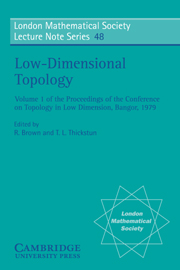Book contents
- Frontmatter
- Contents
- Dedication
- Preface
- Addresses of contributors
- Part 1 3-manifolds
- The classification of compact 3-manifolds
- Hyperbolic geometry and 3-manifolds
- Sewing-up link exteriors
- Periodic transformations in homology 3-spheres and the Rohlin invariant
- Part 2 Knot theory
- Part 3 Two-dimensional homotopy theory
- Part 4 4-manifolds
Hyperbolic geometry and 3-manifolds
Published online by Cambridge University Press: 05 October 2010
- Frontmatter
- Contents
- Dedication
- Preface
- Addresses of contributors
- Part 1 3-manifolds
- The classification of compact 3-manifolds
- Hyperbolic geometry and 3-manifolds
- Sewing-up link exteriors
- Periodic transformations in homology 3-spheres and the Rohlin invariant
- Part 2 Knot theory
- Part 3 Two-dimensional homotopy theory
- Part 4 4-manifolds
Summary
My theme is that geometrical methods yield more information about manifolds than do purely topological methods and in dimension three geometric methods are often applicable, A good example of this is the recent proof of the Smith Conjecture.
Here is the strongest possible conjecture asserting that one can always use geometry when studying 3-manifolds. The Poincaré Conjecture is a very special case.
CONJECTURE, Every compact 3-manifold M with incompressible boundary has a canonical decomposition into geometric pieces, i.e. by cutting M along a canonical family of disjoint, 2-sided, closed surfaces each homeomorphic to S2, P2, T2or the Klein bottle, one can obtain geometric pieces.
When I say that a 3-manifold M is geometric, I mean that the interior of M has a complete geometric structure modelled on some homogeneous space. By a homogeneous space, I shall mean a space X and a transitive group G of homeomorphisms of X with the property that GX, the stabiliser of x, is compact for every x in X. It follows that X admits a G-invariant metric. We will always assume that X is equipped with such a metric and we will usually assume that G is maximal i.e. the full isometry group of X.
A manifold M without boundary has a (X,G)-structure if it is locally homeomorphic to open subsets of X and there is an atlas of charts such that all the overlap maps lie in G.
- Type
- Chapter
- Information
- Low-Dimensional Topology , pp. 9 - 26Publisher: Cambridge University PressPrint publication year: 1982
- 25
- Cited by



